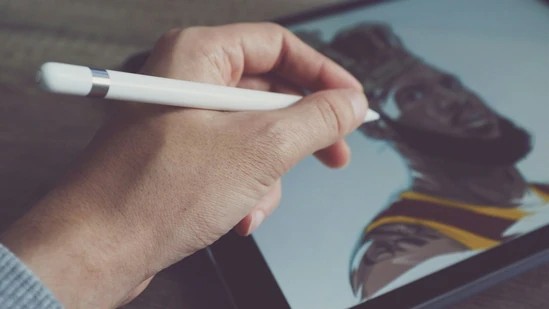The Apple Pencil has evolved from a simple stylus into an indispensable tool for artists, students, and professionals within the Apple ecosystem. Its precision, low latency, and seamless integration with the iPad have set the industry standard. However, its functionality has always been tethered to a screen. Recent patent filings from Apple suggest this limitation may soon be a thing of the past, hinting at a revolutionary new Apple Pencil equipped with an optical sensor system. This next-generation device could operate on almost any surface, transforming it from a digital drawing tool into a universal input device for everything from the iPad and Mac to the Apple Vision Pro. This potential leap forward isn’t just an incremental update; it signals a fundamental rethinking of how we interact with our digital world, representing a significant piece of upcoming Apple Pencil news and a major development in the broader landscape of Apple accessories news.
The Innovation: An Apple Pencil That Works Off-Screen
The core concept revealed in Apple’s recent intellectual property filings is an Apple Pencil that no longer requires a capacitive screen to function. Instead of relying on the iPad’s display to detect its position, this futuristic stylus would have its own built-in navigation system. This innovation would untether the Pencil from a single device’s surface, opening up a world of possibilities for creative and professional workflows.
The Core Technology: Optical Sensors and a Rotating Tip
At the heart of this new technology is a sophisticated optical sensor housed within the Pencil’s tip. This system would function much like a high-performance optical mouse, but miniaturized to fit within the slender chassis of a stylus. The patent describes a tip that can rotate, potentially housing a small trackball-like sphere. An internal light source, likely an LED or a low-power laser, would illuminate the surface beneath the tip. A tiny, high-resolution CMOS sensor would then capture thousands of images of the surface per second.
A dedicated digital signal processor (DSP) inside the Pencil would analyze these images, detecting microscopic textures, patterns, and inconsistencies in the surface. By comparing consecutive images, the DSP can accurately calculate the direction, speed, and distance of the Pencil’s movement. This data would then be transmitted wirelessly to a connected device like an iPad, Mac, or Vision Pro, allowing for real-time cursor control or digital ink flow on any surface—be it a wooden desk, a sheet of paper, or even a user’s leg. This marks a significant development in Apple AR news, as physical surfaces could become interactive digital canvases.
Beyond Drawing: A Multi-Functional Input Device
This technological shift would redefine the Pencil’s purpose. It would evolve from a 2D drawing instrument into a full-fledged 3D input device, or an “air mouse.” The patents also detail the inclusion of additional sensors, such as accelerometers and gyroscopes, to track the Pencil’s orientation in three-dimensional space. This means the device would not only know how it’s moving across a surface but also its roll, pitch, and yaw. Imagine a 3D artist sculpting a model on their Mac by moving and twisting the Pencil on their desk, providing a far more tactile and intuitive experience than a traditional mouse. This innovation is a key piece of the puzzle for the expanding Apple ecosystem news, creating a single tool that can bridge multiple hardware platforms.
Under the Hood: The Engineering Behind a Surface-Agnostic Stylus
While the concept is revolutionary, its execution presents significant engineering challenges. Apple’s success will depend on miniaturizing complex components while maintaining the performance, battery life, and elegant design users expect. The seamless integration with future iOS updates news will be critical for a smooth user experience.

Optical Navigation System Explained
The optical navigation system is the star of the show. To achieve the precision creatives demand, the sensor would need a high Dots Per Inch (DPI) rating, comparable to high-end gaming mice. This ensures that even the most subtle hand movements are captured accurately. The choice of light source is also crucial; an infrared LED is power-efficient, while a laser (like those in Logitech’s high-end MX Master series) offers superior tracking on a wider variety of surfaces, including glossy ones. Apple would need to balance performance with power consumption to ensure the Pencil’s battery life remains practical for all-day use. This focus on internal hardware echoes trends seen in recent AirPods Pro news, where custom chips have enabled new features and improved efficiency.
Haptic Feedback and Rotational Sensing
To make the experience truly immersive, the patent details the inclusion of advanced haptic feedback. A built-in Taptic Engine could generate precise vibrations that simulate the texture of different digital brushes or the feel of drawing on various surfaces like canvas or textured paper, even when the physical surface is a smooth desk. The rotational sensors would add another layer of control. For example, a video editor could use the Pencil to scrub through a timeline with left-to-right movement while twisting it to adjust audio levels. This multi-axis input is a game-changer and could position the Pencil as the ultimate Vision Pro wand news is anticipating, offering a level of precision that hand-tracking alone cannot match.
Power and Connectivity
An active optical sensor and a haptic engine would undoubtedly increase the Pencil’s power draw. Apple would need to incorporate a larger battery or develop more efficient components. Charging would likely continue via magnetic attachment to an iPad, but we could also see a dedicated charging case, similar to AirPods, or USB-C charging for standalone use. For connectivity, the device would rely on a low-latency Bluetooth connection. However, the inclusion of an Ultra-Wideband (UWB) chip, the same technology found in AirTags, is also a possibility. UWB could provide highly accurate spatial awareness, which is critical for AR applications and could be a major highlight in future Apple Pencil Vision Pro news. This commitment to robust security for data transmission would align with Apple’s stringent standards, a frequent topic in Apple privacy news and iOS security news.
Beyond the iPad: A New Role in the Apple Ecosystem
The most exciting implication of this technology is its potential to unify the user experience across Apple’s entire product lineup. The Pencil could become the one accessory to rule them all, seamlessly transitioning between devices and tasks.
The Ultimate Vision Pro Accessory
This is arguably the most compelling use case. While the Apple Vision Pro’s eye and hand tracking is incredibly intuitive for navigation, it lacks the pixel-perfect precision required for many professional tasks. A surface-tracking Apple Pencil would be the perfect solution. A graphic designer wearing a Vision Pro could use the Pencil on their desk to precisely edit a Photoshop file floating in their virtual workspace. An architect could sketch a floor plan on a physical table, with the lines appearing instantly in a 3D model in their augmented reality view. This would establish the Pencil as a premier offering among Vision Pro accessories news, providing a tangible link between the user’s physical environment and the spatial computing interface. It moves beyond a simple stylus and becomes a true creative wand for the AR era.

Unifying the Mac and iPad Experience
The new Pencil could finally bridge the input gap between macOS and iPadOS. For Mac users, it could serve as a highly ergonomic and precise alternative to a mouse or trackpad. For those who use an iPad with a Magic Keyboard, the Pencil could control the cursor from the desk, eliminating the need to constantly reach up to the screen. This aligns with the ongoing trend in iPad news of the device becoming a more capable laptop replacement. An artist could start a sketch on an iPad, then use the same Pencil to add fine details in a desktop application on their Mac without missing a beat.
Potential for iPhone and Beyond
While persistent rumors in iPhone news about Pencil support have yet to materialize, this new technology makes the concept more plausible. An off-screen Pencil could act as a remote or pointer for an iPhone connected to a display. The possibilities extend even further across the ecosystem. Imagine using gestures with the Pencil to navigate the Apple TV news interface or control music playback on a HomePod mini. This universal controller concept is a powerful illustration of Apple’s holistic approach to its ecosystem, where every device, from the Apple Watch to the iPhone, works together seamlessly.
The Road Ahead: Potential and Pitfalls
While the patent is a thrilling glimpse into the future, it’s important to temper excitement with a dose of reality. The path from a patent filing to a consumer product is long and uncertain, filled with technical and market-based hurdles.

The Upside: A Paradigm Shift for Creatives
The potential benefits are immense. For creative professionals, this device represents a paradigm shift. It offers the freedom to work on any surface, the precision needed for high-stakes professional work in both 2D and 3D, and a unified tool that works across the entire Apple ecosystem. A real-world scenario could involve a product designer sketching a concept on paper with the Pencil for an iPad vision board news feature, with the sketch being instantly digitized. They could then pick up their Vision Pro and use the same Pencil on their desk to manipulate that sketch into a full 3D model, creating a fluid workflow that was previously the stuff of science fiction.
The Hurdles: Technical and Market Challenges
The primary challenges will be cost, durability, and battery life. The complex array of sensors, processors, and haptic motors would undoubtedly make this a premium—and expensive—accessory. The delicate optical sensor in the tip would also need to be robust enough to withstand the rigors of daily use on a variety of surfaces. Furthermore, Apple must decide on its market positioning: will this be a new “Apple Pencil Pro” sold alongside the existing models, or will it completely replace the current generation? The answers to these questions will determine whether this innovative device becomes a mainstream success or a niche product for a small group of power users.
Conclusion: A Vision for the Future of Input
The prospect of a surface-agnostic Apple Pencil is more than just an exciting rumor; it’s a clear indication of Apple’s long-term vision for human-computer interaction. This patented technology suggests a future where the line between physical and digital input is completely blurred. By transforming the Pencil from a screen-dependent stylus into a universal controller, Apple is laying the groundwork for the next generation of creative and professional workflows, particularly within the nascent field of spatial computing powered by the Vision Pro. While we must wait for official announcements, this glimpse into Apple’s R&D labs shows a company that is not content with incremental updates. Instead, it is actively designing the tools that will define how we create, work, and interact with technology for years to come.











